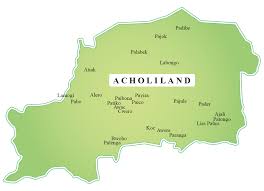By Lamac, A. (2023)
Chiefdom Formation in Lamwo and North-Central Acholiland
The formation of Acholi chiefdoms in northern Uganda, especially in the north-central region around Lamwo, offers valuable insights into precolonial political organization in East Africa. This area, geographically defined by the Aringa River and the Agoro Mountains, became a fertile hub of early chiefdom activity due to its natural defenses and agricultural potential.
By the 18th century, several powerful chiefdoms had emerged here, forming a core part of what we now recognize as Acholi history.
Why Lamwo? Geography and Political Significance
The north-central zone of Acholiland, particularly modern-day Lamwo District, was uniquely positioned for early political development. Its triangular shape, enclosed by the Aringa River’s forks and shielded by the Agoro Mountains, provided both defensive strength and fertile lands for irrigation.
These geographical advantages helped make the area a nucleus of political complexity, surpassing surrounding zones in settlement density and leadership structures.
Early Acholi Chiefdoms in the Lamwo Region
By the mid-1700s, at least eleven Acholi chiefdoms had been established in this zone, including:
-
Madi Kiloc (Parabok)
-
Paloga
-
Lomura
-
Padibe
-
Palabek
-
Madi Opei
-
Smaller polities like Logorone, Popoka, Lamogi, and Pobaar
-
The northeastern polity of Cua-Bura
Another short-lived entity, Pocu, emerged but dissolved before the 18th century’s end.
These chiefdoms represent the earliest forms of structured political authority in northern Uganda, shaped by a mix of Central Sudanic and Nilotic cultural influences.
Parabok (Madi Kiloc): The First Lasting Acholi Chiefdom
Central Sudanic Roots and Migration
The Madi Kiloc chiefdom, originally known as Parabok, is considered the first enduring polity in the area. Oral traditions link its founding lineage to Central Sudanic groups that initially joined the Alero chiefdom further south.
Led by Bako, the son of Parabok’s founder Abok, a splinter group moved north after Alero’s decline, settling in the Aringa Valley between 1710 and 1740.
Integration and Political Emergence
Upon arrival, the Parabok encountered three other Central Sudanic lineages—Oraba, Oceba, and Alarapii. These groups united under the Parabok leadership, formally establishing the Madi Kiloc chiefdom.
Later, Paluo migrants from Labongo challenged this authority. With royal regalia and rainmaking claims, the Paluo earned the backing of some local lineages, including the Oceba and Oraba, and ultimately took control of the chiefdom.
The transition of power remains murky in tradition, but a critical shift occurred: the Oceba lineage retained spiritual stewardship by becoming guardians of the Jok Abayo, the central religious force of the chiefdom.
Palabek Chiefdom: Political Complexity and Contested Origins
An Unclear Beginning: From Baar to Palabek
The Palabek chiefdom is another major polity from this period, though its origins are more fragmented. Early sources link its founding lineage to Baar, a Central Sudanic area, while later traditions mention Anuak and Shilluk—both Luo-speaking groups.
This reflects a broader trend of shifting ethnic narratives in oral history, possibly to align with dominant Luo-speaking identities in later periods.
Founding Figures and Royal Legitimacy
Key figures in Palabek’s formation include:
-
Rwot Kenyi (c. 1650–1710): Settled in the north-central zone and met Anyang, a “Madi” chief with symbols of power. Kenyi was accepted as rwot, while Anyang’s lineage became ritual supporters (lodito pa rwot).
-
Rwot Akanyo and Rwot Laro: Akanyo traveled to Bunyoro or Paluo, returning with a royal drum, only to be replaced by his son Laro. This transfer of symbolic authority solidified Palabek’s emerging royal traditions.
Conflict and Innovation
During Laro’s rule (c. 1710–1749), a violent conflict erupted with the northern Pajok (Farajok) polity. This rare early contact between northern and southern Acholi zones may have introduced royal decentralization, where members of the ruling lineage (kal) governed separate lineages—setting Palabek apart from other southern Acholi chiefdoms.
Lineage Structure of Palabek Chiefdom
Although details are limited, the Palabek chiefdom’s lobong likely included the following:
Central Sudanic origins:
-
Ayu
-
Padwat
-
Logwar
-
Pabita
-
Pakala
Eastern Nilotic origins:
-
Agoro
-
Gem
Only Ayu, Padwat, and Logwar are confirmed to have joined before the 1790s drought, during which Rwot Abi (c. 1770–1800) led Palabek through famine and raids by the Lango Omiro. His likely predecessor was Rwot Gimoro (c. 1740–70), son of Laro, though this connection is uncertain in available sources.
Foundations of Acholi Polities in Northern Uganda
The rise of Acholi chiefdoms in Lamwo—especially Parabok (Madi Kiloc) and Palabek—highlights the complex cultural exchanges and power struggles that shaped precolonial northern Uganda. These early polities reflect the region’s strategic geographic importance, blending Central Sudanic, Nilotic, and Luo influences.
Understanding their stories offers a valuable window into the foundations of Acholi political traditions, setting the stage for later developments across Acholiland.
Next: The History of the Padibe Chiefdom
Stay tuned for the next chapter in this series, exploring the origins and growth of the Padibe chiefdom—another key player in northern Uganda’s political landscape.

